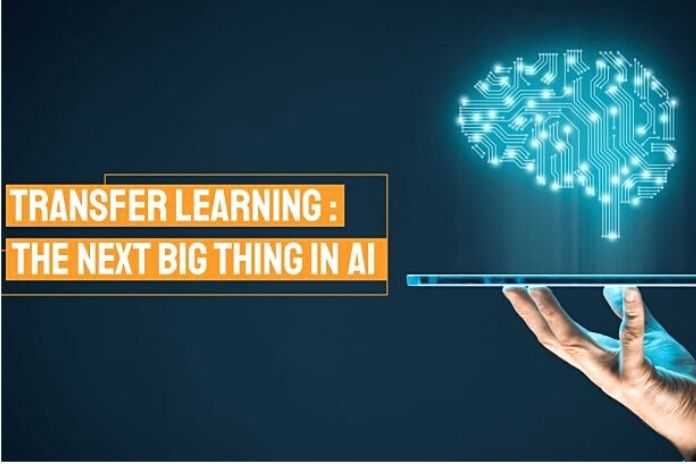Too little training data, no tailor-made models, a lack of know-how: There are many reasons why artificial intelligence in the corporate world is stalling. Transfer learning can help. This allows pre-trained neural networks to be trained for new tasks.
The speech recognition in the cell phone; the photo app, which recognizes that a person is being photographed and automatically adjusts the cameras’ settings; the translation service on the Internet: People today use artificial intelligence in many places in their private lives as a matter of course.
At work, however, it usually looks different. AI has not yet arrived in the world of work as much as it has in private life. Most tasks in offices and the associated processes have so far hardly been simplified by artificial intelligence. There are multiple reasons for this.
The Users Provide The Providers With Comprehensive Training Data
The AI applications widespread in private life are trained using machine learning methods, whereby extensive and, above all, available amounts of data are used. This comprehensive training data is usually supplied to the application providers by their users. With a vast amount of user data, Deep Learning can offer a good translation service. For example, Google’s image search can differentiate Chihuahuas from other dogs. Such mass data is lacking in the vast majority of office activities.
In addition, tailor-made AI models are used in the applications above, each solving closely defined tasks. They are specifically tailored to their purposes and optimized for them. A similar procedure is usually not possible for office work. Since they are very diverse and differ significantly from company to company, it is practically impossible to tailor a model for each activity.
Last but not least, there is often a lack of the necessary expertise. In machine learning projects, problems must be formally specified, then the required data must be obtained and cleaned up, and in the end, the results must be evaluated. In addition, the integration of a machine learning component into existing workflows is highly complex. It takes experienced experts who know how to apply this technology to get the most available data.
Pre-Trained Neural Networks As A Starting Point For New Projects
So-called transfer learning provides a promising approach to solving these challenges. This is a machine learning method in which neural networks that have already been pre-trained for a specific purpose are a starting point for another or more straightforward task. What has already been learned in a neural network can then be used for a new project.
This not only eliminates computationally intensive and time-consuming activities for training a new neural network. With transfer learning, “big data” models can also solve “small data” challenges. Pre-trained with large amounts of data, the models can be further trained with smaller amounts of data for the new task.
This method has already achieved great success in image processing and is now also increasingly used for language models. Using transfer learning technology based on a comprehensive understanding of language, pre-trained language models with relatively little training data are adapted for other tasks.
Language models such as BERT (Bidirectional Encoder Representations from Transformers), ULMFiT (Universal Language Model Fine-Tuning), GPT, and the further developments GPT-2 and -3 (Generative Pretrained Transformer) have already proven that the information learned from a data set is also relatively easy can be used for tasks in other data sets.
When It Comes To Identifying Specialist Topics, Don’t Start From Scratch
A specific area of application is the analysis of documents and information. Companies do not have to start from scratch using the transfer learning method when identifying specialist topics. Instead, a general language model is used and trained or adjusted to a particular subject. Prior knowledge in the form of general language skills is already coded so that the model can recognize sentences or the primary forms of words.
To train it further to classify its documents, it, therefore, needs significantly fewer data. This gives companies and authorities the option of implementing systems that automatically analyze incoming emails and route them to answer them based on their content.
Another area of application is systems for AI-based contract analyzes. With the help of such software, clauses and essential data points in contracts or tenders can be recognized and extracted for targeted checking, risk analysis, commenting, and processing. Specialist lawyers, for example, save a lot of time and enormous resources with this intelligent reading aid, as they no longer have to read contracts individually and manually mark their relevant positions.
This pays off, especially when large volumes of contracts have to be checked in the event of changes in the law or company takeovers. The basis for such a system can be AI software that has already been trained for the most common types of contracts and clauses. Users then have the option.
Transfer Learning Can Advance The Widespread Use Of AI In The Corporate World
The transfer learning method can make an essential contribution to the democratization of artificial intelligence. Compromises indeed have to be made about tailor-made models and complete automation since optimizations cannot be built in a priori. For example, systems that automatically fill out forms cannot be implemented without further ado.
It can, however, be used to implement strategies relatively quickly and efficiently that support users in filling out forms by finding and highlighting the information required for this in the relevant documents – and thus relieving the user significantly. That is why transfer learning has what it takes to promote the widespread use of AI in the corporate world.
Also Read : How Is Artificial Intelligence Used In Digital Marketing?

